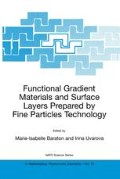Abstract
In the great diversity of technological processes suitable for manufacturing of nanostructured materials, the technology of small particles plays the most important role. This technology is close to conventional powder metallurgy (including the technology of high-temperature oxide and non-oxide ceramics), however when nanosized particles are used they exert a great effect on the main consistencies in the evolution of a disperse system on a way from the ensemble of free particles to the monolithic nanostructured material [1].
Access this chapter
Tax calculation will be finalised at checkout
Purchases are for personal use only
Preview
Unable to display preview. Download preview PDF.
References
Skorokhod, V.V., Ragulya, A.V., (1998) Features of nanocrystalline structure formation on sintering of ultrafine powders, in G.-M. Chow and N.I. Noskova (eds), Nanostructured Materials. Science and Technology, NATO ASI Ser. 3. High Technology, Kluwer Academic Publishers, Dordrecht, Boston, London, 50, pp. 378–404.
Rak, Z.S. (1999) New trends in powder injection molding, Powder Metallurgy, No. 3/4, 16–23.
Hare, T.M. (1979) Statistics of earlier sintering and rearrangement by computer simulation, in G.C. Kuczynski (ed.), Sintering Processes. Materials Science Research, Plenum Press, New York, pp. 77–88.
Kovaltchenko, M.S., Nikolenko, A.M. (1994) Statistical Analysis of Structure Features in Powder Composites in Terms of Random Particles Packing, in Congress Mondial de Metallurgie de Poudres, Les Editions de Physique, Paris, 3, pp. 2295–2298.
Kartuzov, V.V., Kartuzov, E.V., Krassikov, I.V. (1999) Computer generation of two-and three dimensional packing as a background for numerical modeling of sintering processes, Science of Sintering 31, No. 3, pp. 157–162.
Nurkanov, E.Yu., Kadushnikov, R.M., Kamenin, LG., Alievski, V.M., Alievski, D.M., Kartashev, V.V. (2000) Study of density properties of three-dimensional random packing of spherical particles using computer modeling, Powder Metallurgy, in print.
Handwerker, C.A., Blendell, J.E., and Coble, R.L. (1989) Sintering of Ceramics, in D.P. Uskokovic, H. Palmour III., R.M. Spriggs (eds.), Science of Sintering. New Direction for Materials Processing and Microstructural Control, Plenum Press, New York, London, pp. 3–24.
Skorokhod, V.V., Solonin, Yu.V., and Uvarova, I.V. (1990) Chemical, Diffusion and Rheological Processes in Powder Materials Technology [in Russian], Naukova. Dumka, Kiev.
German, R.M. (1978) Sintering Parameter for Sub-micron Powders, Science of Sintering 10, No. 1, 11–25.
Skorokhod, V.V. (1987) Surface relaxation, dynamics of geometrical structure and macro-kinetics of densification during sintering of ultrafine powders, in G.C. Kuczynski, D.P. Uskokovic, H. Palmour III, and M.M. Ristic (eds.), Sintering’85, Plenum Press, New York, London, pp. 81–88.
Ashby, M.F., and Verrall, R. (1973) Non-uniform viscous flow of polycrystalline bodies and superplasticity, Acta Metall., 21, No. 2, 53–61.
Exner, H.E. (1979) Principles of single phase sintering, Rev.of Powder Metallurgy and Physical Ceramics 1, Nos. 1-4, 7–251
Skorokhod, V.V., Panichkina, V.V., Ragulya, A.V. (1999) Effect of size distribution and heating rate on initial and intermediate sintering stages, Functional Materials, 6, No. 2, 215–220.
Skorokhod, V.V. (1999) Rapid Rate Sintering of Disperse Systems: Theory, Processing and Problems, Powder Metallurgy and Metal Ceramics 38, No 7-8, 350.
Kadushnikov, R.M., Skorokhod, V.V. (1991) Research of the zonal separation during sintering of powder bodies by computer modeling methods [in Russian], Poroshk. Metall, No.7, 31–37.
Kadushnikov, R.M., Skorokhod, V.V., Kamenin, I.G., Alievski V.M., Nurkanov, E.Yu., Alievski, D.M. (2000) Three dimension modeling of sintering of spherical particles, Powder Metallurgy, in print
Ragulya, A.V., Skorokhod, V.V. (1997) Validity of Rate Controlled Sintering Method for Consolidation of Dense Nanocrystalline Materials, Proc. of the 14-th Plansee Seminar 2, pp. 735–744.
Palmour III, H. (1989) Rate controlled sintering of ceramics and selected powder materials, in D.P. Uskokovic, H. Palmour III., R.M. Spriggs (eds.), Science of Sintering. New Direction for Materials Processing and Microstructural Control, Plenum Press, New York, London, pp. 337–356.
Mayo, M.J. (1996) Processing of nanocrystalline ceramics from ultrafine particles, Int. Materials Reviews 41, No. 3, 85–115.
Andrievski, R.A. (2000) New Superhard Materials Based on Nanostructured High-Melting Compounds: Achievements and Perspectives, in M.-I. Baraton (ed.), Functional Gradient Materials and Surface Layers Prepared by Fine Particle Technology, NATO ASI Ser. 3. High Technology, Kluwer Academic Publishers, Dordrecht, Boston, London, present issue.
Author information
Authors and Affiliations
Editor information
Editors and Affiliations
Rights and permissions
Copyright information
© 2001 Springer Science+Business Media Dordrecht
About this chapter
Cite this chapter
Skorokhod, V.V. (2001). Topical Problems in the Theory of Technological Processes for the Nanostructured Materials Preparation. In: Baraton, MI., Uvarova, I. (eds) Functional Gradient Materials and Surface Layers Prepared by Fine Particles Technology. NATO Science Series, vol 16. Springer, Dordrecht. https://doi.org/10.1007/978-94-010-0702-3_23
Download citation
DOI: https://doi.org/10.1007/978-94-010-0702-3_23
Publisher Name: Springer, Dordrecht
Print ISBN: 978-0-7923-6925-7
Online ISBN: 978-94-010-0702-3
eBook Packages: Springer Book Archive

